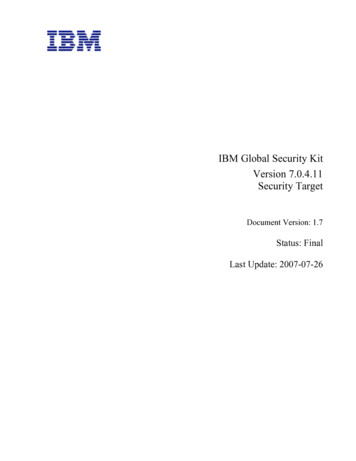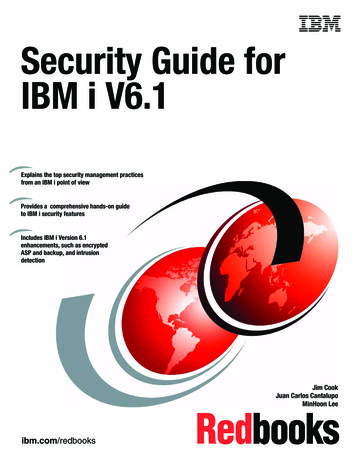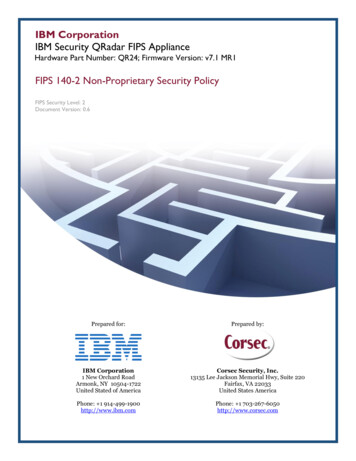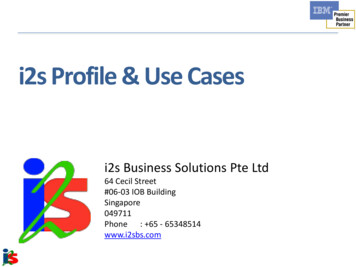
Transcription
IBM Global Security KitVersion 7.0.4.11Security TargetDocument Version: 1.7Status: FinalLast Update: 2007-07-26
IBM Global Security Kit Version 7d Security Targetatsec is a trademark of atsec GmbH.IBM, IBM logo, GSKit, iKeyman and ICC are trademarks or registered trademarks of International Business MachinesCorporation in the United States, other countries, or both.BSAFE is a trademark of RSA in the United States, other countries, or both.Sun Solaris is a trademark of Sun Microsystems, Inc., in the United States, other countries, or both.Microsoft Windows 95, Microsoft Windows 98, Microsoft Windows ME, Microsoft Windows NT, Microsoft Windows2000, Windows 2000 Professional and Advanced Server, and Microsoft Windows XP are trademarks of Microsoft in theUnited States, other countries, or both.HP-UX is a trademark of Hewlett Packard, in the United States, other countries, or both.Linux is a registered trademark of Linus Torvalds.This document is provided AS IS with no express or implied warranties. Use the information in this document at your ownrisk.This document may be reproduced or distributed in any form without prior permission provided the copyright notice isretained on all copies. Modified versions of this document may be freely distributed provided that they are clearlyidentified as such, and this copyright is included intact.Copyright (c) 2004 2006 2007 by atsec GmbH and IBM Corporation or its wholly owned subsidiaries.Page 2 of 69 IBM, atsec 2004-20072007-07-26
IBM Global Security Kit Version 7d Security TargetDocument HistoryVersion DateChangesSummaryAuthor1.72007-07-26 See Summary Removed confidentiality labels and confidential David Ochelparts of the document history. Clarified buildnumber in section 1.1.Page 3 of 69 IBM, atsec 2004-20072007-07-26
IBM Global Security Kit Version 7d Security TargetTable of Content1234Introduction .81.1ST Identification.81.2CC Conformance Claim.81.3Strength of Function.81.4ST and TOE Overview.81.5Structure.91.6Terminology .9TOE Description . 112.1Product Type. 122.2Summary of Security Features . 122.2.1Secure Channel. 122.2.2Cryptographic operations . 132.2.3Self-tests . 152.2.4Key Management . 152.3Software and Guidance . 152.4Security Environment TOE Boundary . 172.4.1Overview . 172.4.2TOE and User Interfaces . 172.4.3Operating Systems and TOE Security Architecture . 182.4.4Certificates. 192.4.5iKeyman, and Keystore . 192.4.6CRLs . 202.4.7OCSP . 202.4.8Crypto Modules. 20TOE Security Environment. 213.1Introduction. 213.2Threats. 213.2.1Threats countered by the TOE . 213.2.2Threats to be countered by measures within the TOE environment. 213.3Organizational Security Policies . 223.4Assumptions . 22Security Objectives. 234.1Security Objectives for the TOE . 234.2Security Objectives for the TOE Environment . 234.2.15TOE Operational Environment . 23Security Requirements . 255.1TOE Security Functional Requirements . 255.1.1Page 4 of 69Cryptographic Support (FCS) . 27 IBM, atsec 2004-20072007-07-26
IBM Global Security Kit Version 7d Security Target5.1.2User Data Protection (FDP) . 295.1.3Identification and Authentication. 325.1.4Security Management (FMT). 325.1.5Protection of the TSF (FPT) . 335.1.6Trusted Path/Channels (FTP) . 355.25.2.1Cryptographic Support (FCS) . 365.2.2User Data Protection (FDP) . 385.2.3Identification and Authentication (FIA) . 385.2.4Protection of the TSF (FPT) . 405.2.5TOE Access (FTA) . 405.36TOE Security Functions. 426.1.1Introduction . 426.1.2Key Management (KEYMAN) . 426.1.3Cryptographic Algorithms (CRYPTO). 446.1.4Secure Channels (SECCHAN). 466.1.5Self-tests and Failure Handling (STATE) . 51Rationale. 537.1Security Objectives Rationale . 537.1.1Security Objectives Coverage . 537.1.2Security Objectives Sufficiency . 547.2Security Requirements Rationale . 567.2.1Explicit Security Functional Requirements Rationale. 567.2.2Security Functional Requirements Rationale . 577.2.3Security Requirements Dependency Rationale . 607.2.4Appropriateness of TOE security assurance requirements. 677.38TOE Security Assurance Requirements. 40TOE Summary Specification . 426.17Security Functional Requirements for the Operational Environment. 35Strength of function Rationale. 67Abbreviations . 69Page 5 of 69 IBM, atsec 2004-20072007-07-26
References[CC]Common Criteria for Information Technology Security Evaluation. Part 1-3. August 2005. Version2.3.[CEM]Common Methodology for Information Technology Security Evaluation. August 2005. Version 2.3.[DOD]Global Security Kit Delivery Procedure Additional Guidance, Version 7.0 as of 2006-07-20[PD-0108]CCEVS Precedence PD-0108: FTP ITC.1.3 Specifies The Functions For Which A Trusted ChannelIs Provided, Effective Date: 2004-07-19, Last Modified Date: 2004-08-26.[RI 58]Final Interpretation for RI # 58 - Confusion over refinement, 07/31/2001[TARGET]Global Security Kit V7d Security Target (this document)[EPRAND]EUROPEAN PATENT APPLICATION EP 1 081 591 A2, Random number generator, Applicationnumber: 00114754.5, Date of publication: 07.03.2001 Bulletin 2001/10.[FIPS46-3]FIPS PUB 46-3: DATA ENCRYPTION STANDARD (DES), October 25, 1999.[FIPS81]FIPS PUB 81: DES MODES OF OPERATION, Issued December 2, 1980, including CHANGENOTICES 2 and 3[FIPS140-2]FIPS PUB 140-2: SECURITY REQUIREMENTS FOR CRYPTOGRAPHIC MODULES, IssuedMay 25, 2001, including CHANGE NOTICES (12-03-2002)[FIPS140IG]Implementation Guidance for FIPS PUB 140-2 and the Cryptographic Module Validation Program,Initial Release: March 28, 2003, Last Update: July 26, 2004[FIPS180-2]FIPS PUB 180-2: Specification for the SECURE HASH STANDARD, including Change Notice toinclude SHA-224, August 1, 2002[FIPS186-2]FIPS PUB 186-2: DIGITAL SIGNATURE STANDARD (DSS), including Change Notice, January27, 2000[FIPS197]FIPS PUB 197: Specification for the ADVANCED ENCRYPTION STANDARD (AES),November 26, 2001.[FIPS198]FIPS PUB 198: The Keyed-Hash Message Authentication Code (HMAC), March 6, 2002.[GSKCAPI]IBM Global Security Kit GSKCapiCmd User’s Guide GSKit Version 7d Edition March 4, 2005[GSKCCMODE]Global Security Kit Common Criteria Mode Operating Guidance for Version 7d Edition March 10,2005[GSKTRUST]IBM Global Security Kit Certificate Validation and Trust Policy Design for version 7c, May 30,2006[GSKKEY]IBM Global Security Kit Key Management for C Programmer's Guide Version 7c, Edition February23, 2005.[GSKINST]IBM Global Security Kit Global Security Kit Install and Packaging Guide, Version 7c, March 6,2005.[GSKPLI]Performing GSKit Local Installations, Version 7.0 as of 2006-08-03.[GSKSSL]IBM Global Security Kit, Secure Socket Layer for C Programmer’s Guide, Version 7c, EditionMarch 9, 2005[ICC]IBM Crypto for c (ICC) Version 1.2 Design Document Version 0.7 – December 29, 2004[ICCDESIGN]IBM Crypto for C (ICC) Version 1.4 Design Document Version 1.4 – March 10,2007[ICCSEC]IBM Crypto for C (ICC) Version 1.4.4 FIPS 140-2 Non-Proprietary Security Policy, version 0.7October 4, 2006.[GUIDE]ISO/IEC PDTR 15446 Title: Information technology – Security techniques – Guide for theproduction of protection profiles and security targets, ISO/IEC JTC 1/SC 27 N 2449, 2000-01-04.[PKCS#11-2.10]PKCS #11 v2.10: Cryptographic Token Interface Standard. RSA Laboratories, December 1999.[PKCS#11-2.20]PKCS #11 v2.20: Cryptographic Token Interface Standard. RSA Laboratories, 28 June 2004.
IBM Global Security Kit Version 7d Security Target[PKCS#12]PKCS 12 v1.0: Personal Information Exchange Syntax, RSA Laboratories, June 24, 1999.[RFC1319]RFC 1319: The MD2 Message-Digest Algorithm, including the Erratum for RFC 1319, April 1992[RFC1321]RFC 1321: The MD5 Message-Digest Algorithm, including the Erratum for RFC 1321, April 1992[RFC2313]RFC 2313: PKCS#1: RSA Cryptography Specification, Version 1.5, March 1998.[RFC2401]RFC 2401: HMAC-Keyed-Hashing for Message Authentication, February 1997.[RFC2437]RFC 2437: PKCS #1: RSA Cryptography Specifications, Version 2.0, October 1998.[RFC2560]RFC 2560: X.509 Internet Public Key Infrastructure Online Certificate Status Protocol – OCSP.June 1999[RFC2986]RFC 2986: PKCS #10: Certification Request Syntax Specification, Version 1.7, November 2000[RFC3280]RFC 3280: Internet X.509 Public Key Infrastructure - Certificate and Certificate Revocation List(CRL), obsoletes RFC 2459, April 2002.[SSLv3]Alain O. Freier, Philip Karlton, Paul C. Kocher: The SSL Protocol, Version 3; IETF Memo, InternetDraft, November 1996.[TLSv1]T. Dierks, C.Allen: The TLS Protocol Version 1.0; RFC 2246, January 1999.[TLS AES]P. Chown: Advanced Encryption Standard (AES) Ciphersuites for Transport Layer Security (TLS);RFC 3268, June 2002.[X.509]ITU-T RECOMMENDATION X.509 ISO/IEC 9594-8: INFORMATION TECHNOLOGY OPEN SYSTEMS INTERCONNECTION - THE DIRECTORY: PUBLIC-KEY ANDATTRIBUTE CERTIFICATE FRAMEWORKS.Page 7 of 69 IBM, atsec 2004-20072007-07-26
IBM Global Security Kit Version 7d Security Target1IntroductionThis document is the security target for the CC evaluation of Global Security Kit (GSKit). The version number 7d is usedalternately throughout this document. 7d refers generically to all 7.0.4.x versions, where the x is a specific build number.For this evaluation, the complete version and build number is identified in section 1.1 below.1.1ST IdentificationST Title:IBM Global Security Kit Version 7.0.4.11 Security TargetST Version:1.7ST Date:2007-07-26TOE Identification:The TOE comprises the Global Security Kit (GSKit) Version 7.0.4.11, including the SSL APIand Key Management API and CLI. GSKit encapsulates the IBM Crypto for C (ICC) Version1.4.5 as an algorithm factory.Keywords:GSKit, SSL, TLS, ICC, OCSP, PKCS#11, PKCS#12.1.2CC Conformance ClaimThis ST is CC Part 2 extended [CC] and CC Part 3 conformant [CC], with a claimed Evaluation Assurance Level of EAL4.No conformance to a Protection Profile is claimed.1.3Strength of FunctionThe overall strength of function claim for this TOE is SOF-high.1.4ST and TOE OverviewThis security target documents the security characteristics of the Global Security Kit (GSKit) Version 7d. GSKit is a set oftools and C/C programming interfaces that can be used to add secure channels using the SSLv3 and TLSv1 protocols toTCP/IP applications (products). It provides the cryptographic functions, the protocol implementation and key generationand management functionality for this purpose. GSKit ships only compiled object code and header files.The TOE consists of GSKit, containingoSSL and TLS functionality which offers an API (called SSL API) for SSLv3 (as defined in [SSLv3]) andTLSv1 (as defined in [TLSv1] with [TLS AES]) connections andokey and certificate generation and management functionality which offers an API (called Key ManagementAPI), and a command line interface (CLI). Key data is stored in a so-called keystore. A keystore isimplemented as access controlled files in the TOE environment. The TOE can be configured to be in CommonCriteria (CC) mode which ensures that the integrity and, where appropriate, the confidentiality of the datastored in the keystore is protected. Alternatively, PKCS#11 devices can be used for key and certificate storage.CC-mode must be used in the evaluated configuration.Furthermore, GSKit encapsulates the IBM Crypto for C (ICC) component, which provides cryptographic functions. TheICC module is validated under the Federal Information Processing Standard (FIPS) 140-2 for an overall Security level 1[FIPS140-2].It is possible to configure the TOE such thatonly SSLv3 and TLSv1 are allowed, other versions of SSL are disabled,only SSL/TLS ciphersuites whose cipherspec parts consist of cryptographic algorithms that are FIPS-approved (as listedin Annex 1 of FIPS 140-2 [FIPS140-2]) and/or NIST-recommended andthe FIPS-approved and/or NIST-recommended random number generatorare used. This approved mode of configuration is called FIPS mode. Please note that the cryptographic algorithms used forkey exchange are not affected by these restrictions.Page 8 of 69 IBM, atsec 2004-20072007-07-26
IBM Global Security Kit Version 7d Security TargetThe product that deploys the TOE must initialize and use the TOE in FIPS mode and in CC mode.The underlying operating systems for the evaluated configuration are identified in section 2.4.3. Operating systems runningthe TOE have to be configured to prevent remote login (by disabling all services that offer remote login) since this isrequired by the FIPS 140-2 security policy for ICC [ICCSEC].The environment must provide reliable timestamps for certificate and CRL verification and an OCSP responder, if the TOEis configured to make use of these services.The processing resources of the TOE must be located within controlled access facilities.The evaluation assumes the operation of the GSKit in an environment that controls the access to the TOE. The TOEservices, the GSKit software, TSF data, and the keystore must be protected. This also includes an appropriate protection ofbackup copies.The use of OCSP responders in the IT environment is supported. Alternatively, the use of certificate revocation lists (CRLs)for certificate validation is available. The TOE can retrieve a CRL using LDAP, flat files or HTTP, check that the signaturesare valid, and, if they are, will use this CRL for certificate validation. If CRLs are to be retrieved via LDAP or HTTP, anLDAP client and an LDAP server or, alternatively, an HTTP server must be available in the TOE environment to provide acurrent CRL containing all revoked certificates.The TOE in the evaluated configuration must not usenon-FIPS approved cryptographic functions of ICC for the cipherspec part of SSL/TLS ciphersuites,SSL versions prior to 3 (due to known weaknesses),“total anonymity mode” for SSL/TLS (i.e. server authentication is mandatory),BSAFE cryptographic library (by RSA).The optional iKeyman GUI that is installed along with GSKit is not part of the TOE. It may be used as a key and certificatemanagement interface within the product using the TOE (see Figure 1). So if it is to be used, it will be part of the TOEenvironment.1.5StructureThe structure of this document is as defined in the following.Section 1 is the introduction.Section 2 is the TOE description.Section 3 provides the statement of the TOE security environment.Section 4 provides the statement of security objectives.Section 5 provides the statement of security requirements.Section 6 provides the TOE summary specification which includes the detailed specification of the IT SecurityFunctions.Section 7 provides the rationale for the security objectives, security requirements, and the strength of functionclaim.Section 8 resolves the abbreviations used.1.6TerminologyThis section contains definitions of technical terms that are used with a meaning specific to this document. Terms defined inthe [CC] are not reiterated here, unless stated otherwise.GSKit: This term serves as an abbreviation for Global Security Kit Version 7d, which is the target of this evaluation.Key Management API and CLI: GSKit API and CLI used by programs that want to deploy the key/certificate generationand management functionality of GSKit.ICC: This is an abbreviation for IBM Crypto for C, a library that is used within GSKit.Page 9 of 69 IBM, atsec 2004-20072007-07-26
IBM Global Security Kit Version 7d Security TargetKeystore: A keystore is a collection of flat files in the IT environment (on the underlying system) managed by the TOE toprovides secure storage for key and certificate data.OCSP: Online Certificate Status Protocol, defined in [RFC2560].SHA-2: Common denominator for the SHA-224, SHA-256, SHA-384 and SHA-512 hash algorithms.SSL: Secure Sockets Layer; this protocol is implemented by the GSKit and available through the SSL API.SSL API: GSKit API used by programs that want to deploy the functionality of SSL or TLS.TLS: Transport Layer security; this protocol is implemented by the GSKit and available through the SSL API.Target of Evaluation (TOE): The TOE is defined as the GSKit Version 7d, running and tested in the environment specifiedin this Security Target.User: A user is a human or a product/application using the TOE or the TOE environment, e.g. a system user uses theunderlying operating system, a TOE user the TOE.Page 10 of 69 IBM, atsec 2004-20072007-07-26
IBM Global Security Kit Version 7d Security Target2TOE tSSL APIKey Management APIOCSPresponderPKCS#12fileCLIGSKitCLISSL/TLSICCHW cryptomoduleKeystoreTOEBoundaryFigure 1: GSKit OverviewThe TOE consists of the IBM Global Security Kit (GSKit).The TOE’s main function is to provide a secure channel to another trusted IT-product. This is shown in Figure 1. Optionalcomponents have been drawn with dotted lines and white components are part of the TOE environment. The TOEcomponents have been colored dark grey and the box surrounding them shows the TOE boundary. The secure channel setup by the TOE is depicted as a pipe named SSL/TLS.The following interfaces are offered to the user:SSL API: this is the main API for the product is the SSL API of the GSKit. For the evaluated configuration of the TOE,only secure connections using SSLv3 and TLSv1 are supported by the TOE in FIPS mode.Key management API and command line interface (CLI): through this API and the CLI, key and certificate generationand management functionality (like validation or deletion of certificates) can be accessed. A product that uses the TOEshall access the keystore through these interfaces only.The TOE encapsulates ICC for software-based cryptographic functions and key generation.Certificate validation may be done with the help of OCSP or CRLs. If CRLs are to be used for certificate validation, LDAPor HTTP resources or a flat file containing the revocation list must be provided by the TOE environment. Likewise, for theusage of OCSP, an OCSP responder must be provided by the environment.Key management tools other than the CLI, e.g., iKeyman, are not part of the TOE.The classification of the different data types is given in the following:User data: User Data is information stored in TOE resources that can be operated upon by users in accordance with theTSP and upon which the TSF places no special meaning. In this category falls all data that is not listed under TSF datasince according to the CC, all data is either user or TSF data.TSF data: TSF data is information used by the TSF in making TSP decisions; for this TOE it isocritical security parameters, Page 11 of 69key data, IBM, atsec 2004-20072007-07-26
IBM Global Security Kit Version 7d Security Target2.1 random number seed, random numbers used for cryptographic operations, passwordsoconfiguration parameters,ocertificates,oCRLs,oOCSP responses, andothe security attributes given below for the objects they belong to: for the TOE: the configuration parameters FIPS mode and CC mode, for SSL/TLS connection: ciphersuite used, session keys, mode (client mode or server mode), inserver mode: authentication type (whether client authentication is required or not), and whetherCRLs are used for certificate verification, for the keystore: the password and the hash value, for hardware crypto modules accessed via PKCS#11: the PIN, for PKCS#12 formatted files: the password, for communication partners: the public key certificate, for certificates: the trust status.Product TypeGSKit is a library that can be used as a component within a larger product; it is intended to be integrated into such a productto provide this product with the capability to use an SSL- or TLS-protected communication channel to another product,providing authentication of the communication partners and protection against disclosure or undetected modification of thedata transferred over this trusted channel. Furthermore, GSKit offers a command line interface which can be used foraccessing key generation and management functions of GSKit, for example by a human user rather than by a program.For (optional) client and (mandatory) server authentication, X.509 [X.509] certificates are used. These certificates can beimported from the environment. In addition to that, GSKit offers certificate generation and management functionality.GSKit requires the product it is integrated into and the underlying operating system to provide the protection of the GSKitexecutables, security attributes and data, especially cryptographic keys and certificates. This includes a correctconfiguration of the TOE and that the processing resources of the TOE must be located within controlled access facilities.2.2Summary of Security FeaturesThe security features provided by GSKit are described in the following paragraphs.2.2.1Secure ChannelThe TOE offers a secure channel for the confidentiality and integrity protection of data transmitted over that channel.
[GSKINST] IBM Global Security Kit Global Security Kit Install and Packaging Guide, Version 7c, March 6, 2005. [GSKPLI] Performing GSKit Local Installations, Version 7.0 as of 2006-08-03. [GSKSSL] IBM Global Security Kit, Secure Socket Layer for C Programmer's Guide, Version 7c, Edition March 9, 2005










